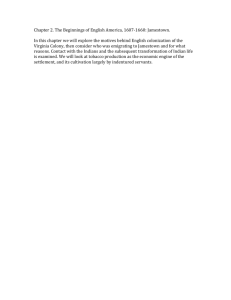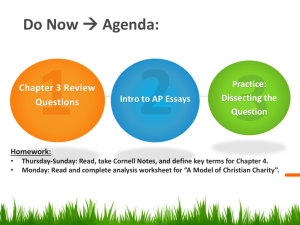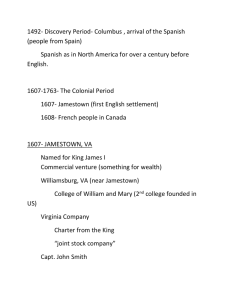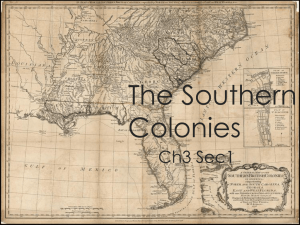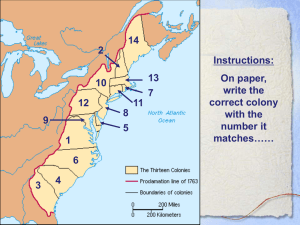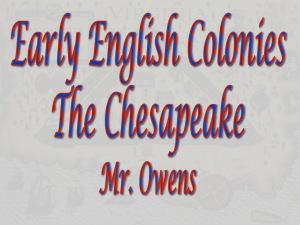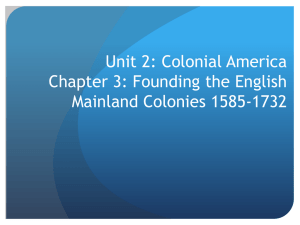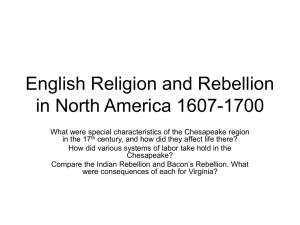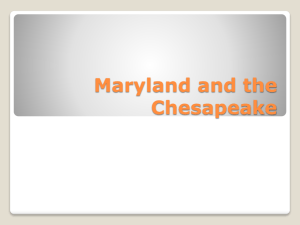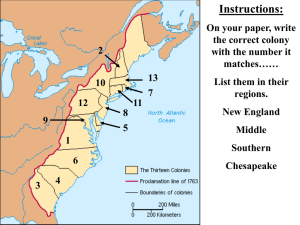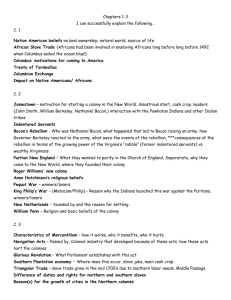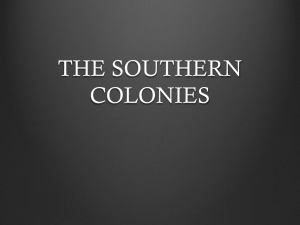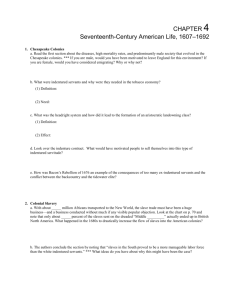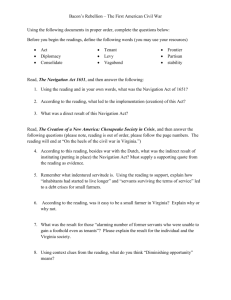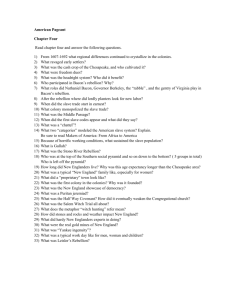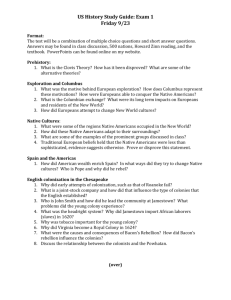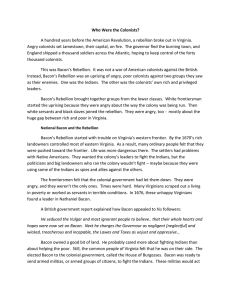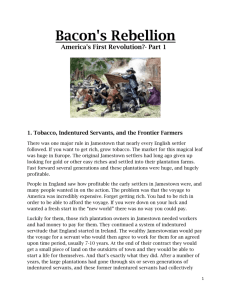The Southern Colonies
advertisement
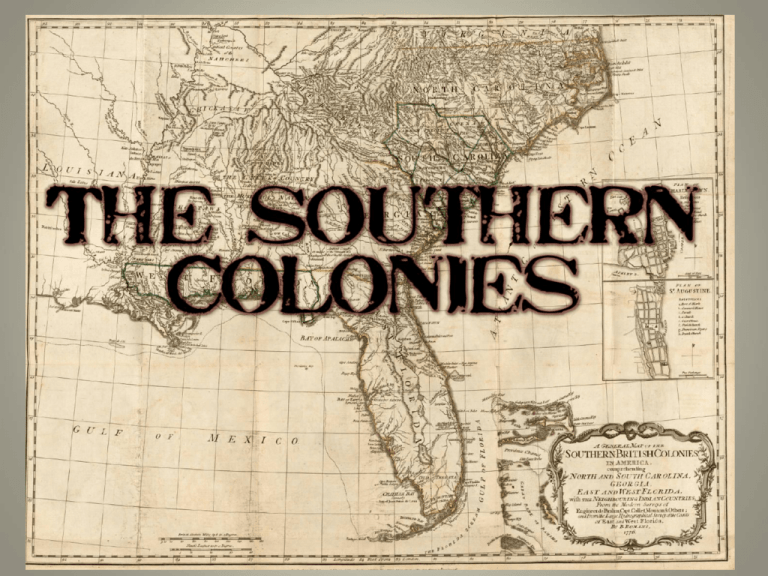
English Settlement in the South • 1606: James I granted a charter creating 2 branches of the Virginia Company of London: – The Plymouth Company – London Company • Motives for settlement: – Gold – Passage to Asia – Converting Indians to Christianity • April 1607: London Company settles Jamestown – 100 settlers led by Capt. Christopher Newport – Selected the peninsula on the James River out of the concern for effective defense – Area was ridden with malaria Jamestown • Initial poor leadership • John Smith eventually provides effective leadership • John Rolfe establishes tobacco crops • Tobacco – 1616: 2500 lbs produced – 1618: 30,000 lbs produced – 1627: 500,000 lbs produced • Tobacco profits off-set the fruitless search for gold Jamestown • The charter is an important document in that it guaranteed the overseas settlers the same rights of Englishmen who were still in the homeland. • Relationship of John Smith and Pocahontas • http://www.youtube.com/watch?v=IHBlEuFoLY Virginia • The first slaves came in the late 1600s • Initially, the headright system provided labor force – Settlers arranged their own transportation and that of dependents in return for 50 acres per “head” transported – Initially preferred indentured servants • 1622: massive Indian attack reduces population by 250 • 1624: James I sees Virginia as a bad investment and revokes the charter • Creation of the House of Burgesses • By 1670, there were 30,000 inhabitants Maryland • Lord Baltimore (Sir George Calvert) wanted his own colony for the personal advantage of his family and for the benefit of Roman Catholics (who were encouraged to settle there) • Selected St. Mary’s as the first settlement • Representative gov’t (like Virginia) • Didn’t turn out to be Catholic refuge it was hoped to be Carolinas • • • • • Chartered in 1663 Representative assembly Largely Protestant Settled by some French Huguenots Also settled by some West Indian planters (who brought slavery to the South Carolina region) – Wanted pine trees for ship building – Rice became a major crop in Carolina Georgia • Established in 1713 • Founded by Gen. James Oglethorpe as a buffer between the British and Spanish (in Florida) • Also used as a debtor’s colony (criminals and convicts from GBR) Life in the Chesapeake • Ridden with malaria, dysentery, typhoid, and other diseases • High death rate • Difficult to start families and create solid settlements • Tobacco Economy – The climate/soil was hospitable to tobacco cultivation – More tobacco means more labor, but where will this labor source come from? Life in the Chesapeake • Headright System – To encourage the importation of servant workers – Whoever paid the passage of a laborer received the right to acquire 50 acres of land – Masters (not the servants) reaped the benefits of landownership from the headright system • the beginning of the rich planter class with extensive land holdings – As land became more scarce, masters became more reluctant to have land allowances in the “freedom dues” • More harsh treatment of servants • You would be free after 7 years, but then you’d be a poor farmer with little choice but to sell yourself back into servitude Triangular Trade Bacon’s Rebellion • There were an increasing number of poor freemen in the Chesapeake region – Frustrated by their broken hopes of acquiring land and getting rich – This growing class of “freemen” made the rich planter class nervous • Gov. Berkeley- governor of VA colony – Was growing increasingly agitated with the large number of rowdy poor throughout the colony Bacon’s Rebellion • The freemen were moving westward towards the Indian settlements and were fighting w/ them on a regular basis – Resented Berkeley’s friendly Indian policies • Berkeley had refused to avenge several brutal Indian attacks on the frontiersmen • So Bacon and his men disobeyed Berkeley and attack/murder the Indians – 1676: Nathaniel Bacon leads about 1,000 men on a raid of Jamestown (the colonial capital of VA) – Torches the town; Berkeley flees and returns w/ English troops Bacon’s Rebellion • Bacon suddenly dies (illness) • Berkeley brutally crushes all Bacon supporters • Results of the Rebellion – Awakened the latent unhappiness of the landless former servants – Pitted the backcountry frontiersmen against the gentry plantation owners – The lordly planters now looked for a different source for plantation labor Slave Trade • The Royal African Company lost its charter in 1698 – enterprising colonists rushed to cash in on the lucrative slave trade (especially Rhode Islanders) • By 1750, the slave trade had ground to a halt • By the 1660s, specific “slave codes” had been drawn up by the colonial gov’ts to delineate between servants’ and slaves’ rights Colonial Slavery • About 10 million Africans were carried over the course of 3 centuries • First Africans came to Jamestown in 1619 (about 2,000) • Slaves were too expensive for struggling colonists • But in the 1680s, rising wages in England shrank the pool of servants coming over – Bacon’s Rebellion had brought a distrust of current and former servants, as gentry feared future rebellions
